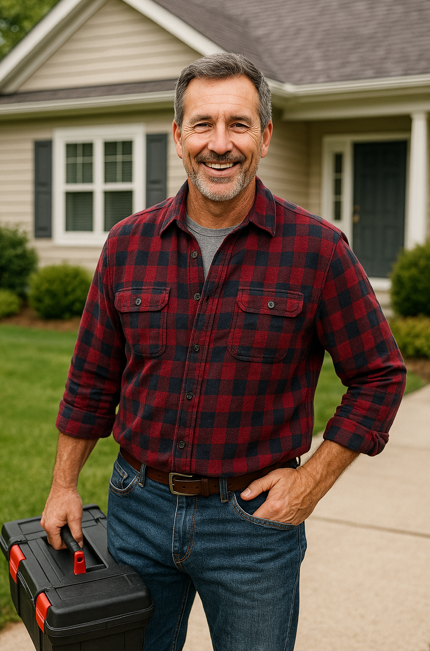🤝 Mike Sanders Here: Let’s Make Sure You Get It Installed Right
Hey there—Mike Sanders here. If you’re thinking about switching to an electric furnace, you're in good company. No gas lines, fewer emissions, and less maintenance? Hard to argue with that. But let me be clear: just because it doesn’t burn fuel doesn’t mean it’s a DIY job.
Whether you’re replacing an old gas system, upgrading from baseboard heaters, or outfitting a brand-new build, installing an electric furnace takes planning, permits, and pros who know what they’re doing.
This guide covers the full picture: what to expect, what to ask your contractor, and what you need to budget for a proper install.
🔋 Step 1: Is Your Electrical Panel Ready?
Electric furnaces draw a lot of power. That means your home’s electrical panel needs to be up to the job.
What to check:
-
Voltage: You’ll need a 240V circuit
-
Amperage: Most furnaces require 60–100 amps
-
Panel space: There must be room for a double-pole breaker
If your panel is maxed out or undersized (common in homes built before the 90s), you’ll need a panel upgrade, which can run between $1,200 and $3,000.
Need to learn more about residential service sizes? The National Electrical Code summary from NFPA lays out current safety standards.
🚧 Step 2: Choosing the Right Furnace Location
The best place for your electric furnace depends on your home’s layout, ductwork, and available space. Common install spots include:
-
Basements (great airflow, but check humidity)
-
Garages (as long as it’s insulated)
-
Closets or utility rooms (make sure there’s enough clearance)
Your HVAC pro will need to meet clearance requirements for safety and airflow, as well as comply with local building codes.
If your ducts need to be extended or rerouted, factor that into your budget. Visit ENERGY STAR’s guide on HVAC installation to see how ductwork quality can impact comfort and efficiency.
🔢 Step 3: Load Calculations and Furnace Sizing
Getting the furnace size wrong is one of the most common mistakes homeowners make. Go too small, and you’ll never feel warm. Too big, and your unit will short-cycle and waste energy.
Professional installers should run a Manual J load calculation, which accounts for:
-
Home square footage
-
Insulation R-values
-
Window size, type, and orientation
-
Air leakage and duct losses
Need a ballpark figure before talking to a contractor? Try the LoadCalc HVAC calculator to estimate your home’s BTU requirements.
🔧 Step 4: Understanding the Installation Process
Here’s what you can expect on installation day (and the prep leading up to it):
-
Site Prep
-
Clear area for the furnace and tools
-
Ensure panel access and duct connections
-
-
Electrical Work
-
New circuit with appropriate gauge wiring
-
Dedicated double-pole breaker
-
Disconnect box within line of sight of the unit
-
-
Duct Connection
-
Hooking up supply and return ducts
-
Sealing joints with mastic or UL-181 foil tape
-
-
Thermostat Wiring
-
Most units support standard 24V thermostats
-
Smart thermostat compatibility may require a C-wire
-
-
System Testing
-
Airflow balancing
-
Static pressure testing
-
Safety inspections and code compliance
-
Pro tip: Always get a post-install inspection from your local building department or utility provider. It ensures safety and validates any rebates.
💸 Step 5: Cost Breakdown and Budgeting
Electric furnace installs vary widely in price depending on your home setup and whether any upgrades are needed.
General pricing:
| Component | Typical Cost Range |
|---|---|
| Electric Furnace Unit | $800 - $2,500 |
| Installation Labor | $1,500 - $3,500 |
| Panel Upgrade (if needed) | $1,200 - $3,000 |
| Duct Modifications | $500 - $2,000 |
| Thermostat (smart) | $150 - $400 |
Total installed cost usually falls between $3,000 and $7,000.
Want to dig into detailed numbers? Try HomeAdvisor’s furnace installation calculator.
✅ Step 6: Permits, Inspections, and Rebates
Permits
You’ll likely need a mechanical and electrical permit to install an electric furnace. Fees vary by county but typically cost $100-$500.
Inspections
Most jurisdictions require at least one final inspection. Your HVAC pro should handle the scheduling.
Rebates
Some utilities offer rebates for upgrading to high-efficiency electric heating—especially if you’re replacing gas.
Check your eligibility through the DSIRE incentive database.
🧳 Tips for Hiring a Contractor
Not all HVAC contractors are experienced with electric furnaces. Here’s what to look for:
-
State license and insurance
-
Experience with electric systems (ask for references)
-
Manual J calculation included in quote
-
Clear timeline and install checklist
-
Willingness to pull permits
Ask these five questions before you hire:
-
Are you licensed and insured in my state?
-
Will you perform a Manual J load calculation?
-
Do you see any issues with my panel or ductwork?
-
What’s your warranty on labor?
-
Can you help me apply for rebates or inspections?
🏠 Wrapping Up: The Smart Way to Switch to Electric
Switching to an electric furnace is a smart move for a lot of homeowners—especially if you want a clean, reliable, all-electric heating solution.
Just make sure you cover all your bases:
-
Your panel can handle the load
-
Your ductwork is airtight and properly sized
-
Your installer knows electric heat inside and out
-
You budget for permits and any needed upgrades
When you’re ready to shop, head over to The Furnace Outlet's electric furnace collection for trusted brands, clear specs, and honest pricing.
Until next time, stay safe and stay warm—
Mike Sanders







